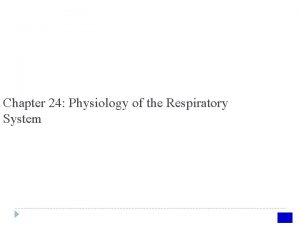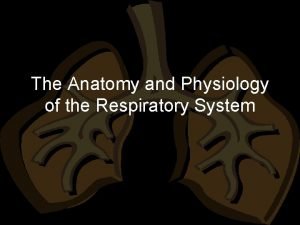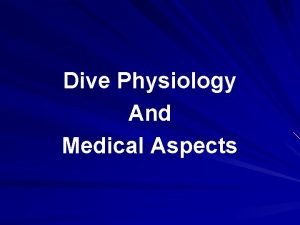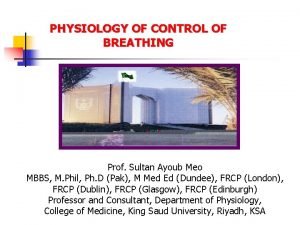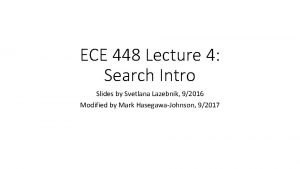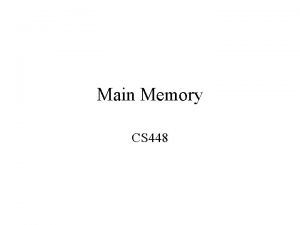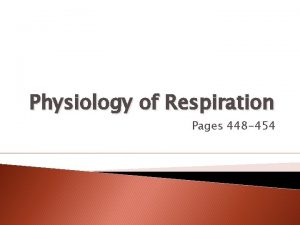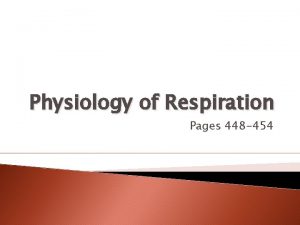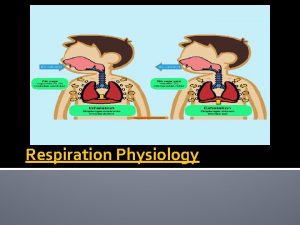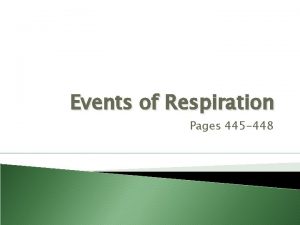Physiology of Respiration Pages 448 454 Figure 13













- Slides: 13

Physiology of Respiration Pages 448 -454

Figure 13. 9 Idealized tracing of the various respiratory volumes of a healthy young adult male. 6, 000 Milliliters (ml) 5, 000 4, 000 3, 000 2, 000 1, 000 0 Inspiratory reserve volume 3, 100 ml Tidal volume 500 ml Expiratory reserve volume 1, 200 ml Residual volume 1, 200 ml Vital capacity 4, 800 ml Total lung capacity 6, 000 ml

Respiratory Volumes and Capacities § Tidal Volume (TV): total air moved with each breath § Inspiratory reserve volume (IRV): § Normal breathing moves about 500 ml § Amount of air that can be taken in forcibly over the tidal volume § Usually around 3, 100 ml § Expiratory reserve volume (ERV): § Amount of air that can be forcibly exhaled after a tidal expiration § Approximately 1, 200 ml § Residual volume: Air remaining in lung after expiration (about 1, 200 ml) § Allows gas exchange between breaths; keeps alveoli inflated © 2015 Pearson Education, Inc.

Respiratory Volumes and Capacities § Vital capacity (VC): § The total amount of exchangeable air § Vital capacity = TV + IRV + ERV § Avg. 4, 800 ml in men; 3, 100 ml in women § Dead space volume: about 150 ml § Air remaining in resp. tract; never reaches alveoli § Functional volume: about 350 ml § Air that actually reaches the respiratory zone § (bronchioles/alveoli) spirometer –measures respiratory capacities © 2015 Pearson Education, Inc.

Nonrespiratory Air Movements § caused by reflexes or voluntary actions § Cough and sneeze —clears lungs of debris § Crying/laughing —emotionally induced mechanism § Hiccup —sudden inspirations § Spasms/irritation of diaphragm or nerve § Yawn —very deep inspiration Thought to cool CSF/brain blood © 2015 Pearson Education, Inc.

Respiratory Sounds Ø Ø Soft murmurs like a muffled breeze Monitored with a stethoscope Ø Bronchial sounds –air through large passageways Ø trachea/bronchi Ø Vesicular breathing sounds - alveoli filling with air © 2015 Pearson Education, Inc.

Gas Transport in the Blood Oxygen: ◦ Most attaches to hemoglobin to form oxyhemoglobin (Hb. O 2) ◦ small dissolved amount is carried in the plasma Carbon dioxide: ◦ Most transported in plasma as bicarbonate ion (HCO 3–) ◦ eventually released into RBC to form carbonic acid (H 2 CO 3) splits to release CO 2 ◦ Small amount carried in RBC bound to hemoglobin (at different sites than oxygen) © 2015 Pearson Education, Inc.

Figure 13. 11 a Diagrammatic representation of the major means of oxygen (O 2) and carbon dioxide (CO 2) loading and unloading in the body. (a) External respiration in the lungs (pulmonary gas exchange) Oxygen is loaded into the blood and carbon dioxide is unloaded. Alveoli (air sacs) O 2 Loading of O 2 Hb + O 2 Hb. O 2 (Oxyhemoglobin is formed) CO 2 Unloading of CO 2 HCO 3−+ H+ Bicarbonate ion H 2 CO 3 Carbonic acid CO 2+ H 2 O Water Plasma Red blood cell Pulmonary capillary

Figure 13. 11 b Diagrammatic representation of the major means of oxygen (O 2) and carbon dioxide (CO 2) loading and unloading in the body. (b) Internal respiration in the body tissues (systemic capillary gas exchange) Oxygen is unloaded and carbon dioxide is loaded into the blood. Tissue cells CO 2 Loading of CO 2 +H 2 O H 2 CO 3 Water Carbonic acid Plasma O 2 Unloading of O 2 H++ HCO 3− Bicarbonate ion Hb. O 2 Hb + O 2 Systemic capillary Red blood cell

Neural Regulation of Respiration Nerves: the phrenic and intercostal nerves ◦ Control diaphragm and external intercostals Medulla: ◦ Sets breathing rate and depth of breathing ◦ Controls overinflation of alveoli Stretch receptors in alveoli too ◦ contains a pacemaker (self-exciting inspiratory center) called the ventral respiratory group (VRG) Pons—coordinates/smooths respiratory rate © 2015 Pearson Education, Inc.

Figure 13. 12 Breathing control centers, sensory inputs, and effector nerves. Breathing control centers: • Pons centers • Medulla centers Efferent nerve impulses from medulla trigger contraction of inspiratory muscles. • Phrenic nerves • Intercostal nerves Afferent impulses to medulla Breathing control centers stimulated by: CO 2 increase in blood (acts directly on medulla centers by causing a drop in p. H of CSF) CSF in brain sinus Nerve impulse from O 2 sensor indicating O 2 decrease Intercostal muscles Diaphragm O 2 sensor in aortic body of aortic arch

Factors Influencing Respiratory Rate and Depth • Physical factors/Emotional Factors – Increased body temperature/Exercise – Talking/Coughing – Fear, anger, excitement • Conscious control): holding your breath • Respiratory centers override this when oxygen gets too low and p. H drops © 2015 Pearson Education, Inc.

Factors Influencing Respiratory Rate and Depth • Chemical : – Increased levels of carbon dioxide causes: • decreased or acidic p. H of CSF • an increase in rate and depth of breathing • The body’s need to rid itself of CO 2 is the most important stimulus for breathing • Acts directly on the medulla oblongata • Changes in Oxygen are monitored by chemoreceptors in the aorta and carotid © 2015 Pearson Education, Inc.
 Printed pages vs web pages
Printed pages vs web pages What is the physiology of respiration
What is the physiology of respiration Inspiration anatomy and physiology
Inspiration anatomy and physiology Physiology of respiration
Physiology of respiration What is the physiology of respiration
What is the physiology of respiration Peripheral chemoreceptors
Peripheral chemoreceptors Internal respiration vs external respiration
Internal respiration vs external respiration External respiration vs internal respiration
External respiration vs internal respiration Ece 448
Ece 448 Ece 448
Ece 448 Cs 448
Cs 448 Ece 448
Ece 448 Ece448
Ece448 Ece 448
Ece 448

